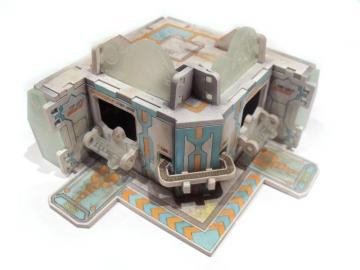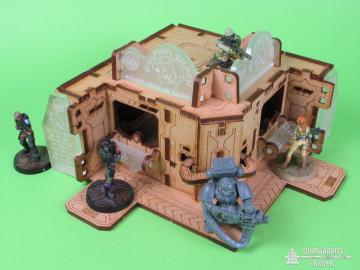Company: Warmill Gaming AccessoriesRetail Price:
£23.99
Warmill's growing range of Street Wars scenery now includes several different types of building, including this retail food booth. Looks & Styling It's unavoidable that kits made from laser-cut sheet material are blocky, but the design of the Foodbooth does a decent job of disguising this by breaking up the planes with multiple corners, angled walls etc. While having a strong SF/Bladerunner/Japanese look, it manages to still be generic enough that it should fit on most SF tables that aren't post-apocalyptic wastelands, even urban non-ruin 40k tables!
Parts, Fit and Construction The kit comes in a small corrugated cardboard box, containing three sheets of laser-cut MDF plus some etched acrylic pieces. As with the PUP, this is not a snap-fit kit and it will definitely need gluing during construction. Again, as with the PUP, it is made of relatively low density MDF with a semi-porous surface. The kit contains quite a number of parts once they're separated from the sheets, as seen below. Instructions: The instruction sheet was missing from the box but an email to Warmill got me a PDF version the next morning. The multi-step instructions do need to be followed in order as you can end up tying yourself in knots if you try to do things in the wrong order! Construction starts with the inner corner of the wall and works around until all the walls are done, the walls then glue into the base plate and the roof is added last. Once the first two walls are together, the inner part of the conveyor belt is added: The outer section of conveyor is then added, sitting on a couple of little struts out from the wall. Then the first set of corners are added, on the other sides of the serving hatches. Then the back walls are assembled on their upright ribs. Followed by a neat little sideboard that fits on the inside of the wall. ‘Ready to cook dinner, dear?’ ‘Let me reminder you who’s carrying the gun, “dear”.’ The other back wall is more complex in shape due to the door, and has the washing basin sideboard. The door itself must be glued together in the right order, if you glue the larger panel in place first then it's impossible to get the small panel on. Thanks to the small holes in the wall and protruding pins on the inside of the door, the door can be positioned closed, semi-open or fully open, a nice change from the door on the PUP. Now comes the tricky bit - the back walls need gluing to the front half and the whole lot needs fitting into the holes in the base board, then the majority of the contrsution is done. The last wall piece being added to cover the back corner. The last pieces to add to the walls are the acrylic menu panels and the ordering panels, which will have to be left off until after painting anyway. The roof section uses a robust crossed-panel construction but but due to the 'all-at-once' construction will need painting before any glue is applied. The roof section is a very snug fit onto the top of the walls, due to the complex shape and large amount of contact. I'm planning to sand down the contact areas for a looser fit and then add a few magnets to hold it in place. The assembled piece! Construction from opening the packet to the finished item took about an hour including gluing time.
Scale and Dimensions The kit is scaled for use with 28mm models. The external dimensions of the piece are 146x150mm (including baseplate tongues and door ribs) by 78mm high. The internal height is 47mm, easily high enough for Space Marines and Terminators but not for the spines on Chaos Terminators or for models waving guns in the air. The doorway is 30mm wide at the narrowest with a slight flare at the bottom by 38mm high. Anything smaller than a Terminator will easily fit through the doorway. Assembled unpainted weight is 142g.
Game Use and Robustness With it's multiple corners and roof display the piece has plenty of places to take cover behind. Also, with it's door and two serving hatches there are multiple ways in and out, a minor failing for the 'dead-end' PUP. With the usual 3mm MDF construction the model is very robust, with the more vulnerable/thinner ordering panels and conveyor belt being protected by the angle of walls and baseplate.
Summary An excellent addition to the range of laser-cut scenery on the market, there are very few commercial/retail scenery pieces available at the moment.
Pros
Cons
Ian
|
|||
 |
||||||||
|
|
|











































